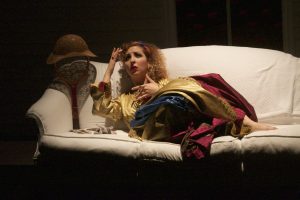Brandeis’ newest production, “Fefu and Her Friends,” serves as an example of how powerful realist drama can be with its emotional portrayal of women’s lives.
The 1977 play, written by María Irene Fornés follows the titular characters through a day they spend rehearsing for a presentation they will be giving to help raise money for their educational charity. As the day progresses their interactions become more dramatic as they share more, revealing how their romances have been interrupted or how they have fallen into the grips of anxiety and depression.
 As these issues come to light, the atmosphere becomes more tense until it ends with an explosive climax. When the play was first performed it was hailed for its alternative staging and strong portrayal of women’s societal issues. Though the Brandeis production leaves out the alternative staging, which involved rotating sections of the audience between different scenes being performed simultaneously, the feminist themes are conveyed with an impressive strength and subtlety.
As these issues come to light, the atmosphere becomes more tense until it ends with an explosive climax. When the play was first performed it was hailed for its alternative staging and strong portrayal of women’s societal issues. Though the Brandeis production leaves out the alternative staging, which involved rotating sections of the audience between different scenes being performed simultaneously, the feminist themes are conveyed with an impressive strength and subtlety.
The core of Brandeis’ staging, created by director Adrianne Krstansky (THA), comes from the way the actors switch between conversational moods, from casual small talk to deeper and more intimate conversations that betray their true situation. When the play starts, the performance is mainly reminiscent of conversations between friends, with a self-deprecating tone surprisingly like post-millennials’ conversations. But as the friends open up, their portrayal becomes more reminiscent of 1 a.m. conversations as the actors lose their veneer of calm and become more possessed by their psychological horrors.

These transitions are heavily aided by deft technical design, particularly the work of lighting designer Jeff Adelberg and sound designer/composer Dewey Dellay. Each level of tension is accompanied by a separate lighting scheme which sets the tone for the scene, such as a sickly green which comes with the uncanniest scenes. Transitions and emotional moments are similarly set by Dellay’s deftly distorted and disturbing musical accompaniments.
The simple set, designed by Cameron Anderson (THA) and consisting of a striking backdrop of a house and simple furniture, places the show in 1930s New England without drawing attention from the action of the stage. Similarly, the costume design by Mary Hurd (THA) places the show while also reinforcing and revealing details about the characters, such as the dramatic flair of Fefu’s theatrical friend Emma (Haia Bchiri ’20).
The actors match this impressive technical suite with remarkable performances of their own. Rebecca Myers ’18 as Fefu, the eerily violent hostess, and Sara Kenney ’18 as Julia the shell-shocked cripple, head the show with a slow transition into desperate distress which drives home the suffering they live in. They are contrasted by Roopa Boodhun ’18 as the “conformist” disturbed by the others’ energy and naked anguish. Alex Wu ’19 is similarly impressive as Cecilia, with a hesitation and forced calm typical which belie her detachment and lack of emotional attachment to the others. This is the opposite of Emma who embraces a passion and lack of shame to become the flamboyant center of the group’s energy.

At its core, “Fefu” is a play about eight women talking to each other. At Brandeis, Krstansky used it to exemplify the potential such a play about everyday life has to make us confront the realities of our society. This performance forces us to confront the realities of our situation and does so without heavy-handedness or lecturing.
“Fefu and Her Friends” is playing through Oct. 22, 2017, at 8 p.m. on Friday, 2 p.m. and 8 p.m. on Saturday and 2 p.m. on Sunday, in the Laurie Theater in Spingold Theater Center. For tickets, call 781-736-3400, buy them in-person at the SCC or Spingold box offices or get them online.


